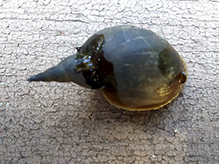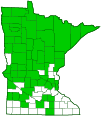great pond snail
(Lymnaea stagnalis)
Conservation • Description • Habitat • Biology • Distribution • Taxonomy
Conservation Status |
|
|||||||
| IUCN Red List | LC - Least Concern |
|||||||
| NatureServe | N5 - Secure S5 - Secure |
|||||||
| Minnesota | not listed |
|||||||
Description |
||
Great pond snail is a very large, air-breathing, freshwater snail. It occurs in Europe, Asia, North America, and southern Australia. It occurs throughout the United States and Canada, but it is uncommon south of the 40th parallel. It is common in Minnesota. It is found in permanent, slow or still waters, usually with dense vegetation, including creeks, streams, rivers, marshes, swamps, and reservoirs, and at the edges of lakes and large ponds. Great pond snail is commonly sold as an aquarium pet. It has recently become the subject of scientific research into handedness (chirality). Adults can be 1¾″ to 2¾″ (45 to 70 mm) long and ¾″ to 13⁄16″ (20 to 30 mm) wide, but they are usually no more than 2¼″ (56 mm) long. The shell is thin and fragile. It has 4½ to 6 complete (360°), weakly convex rotations (whorls). The last whorl (body whorl) above the opening is suddenly and greatly inflated. The remaining whorls are elevated and gradually reduced in size, forming a long, sharply pointed spire. When seen with the tip at the top and the opening facing up, the opening is on the right side. This is referred to as an elevated spire, right-handed, shell. There is no door-like structure (operculum) covering the opening of the shell. The shell base color is variable, from tan to dark brown. It has no obvious markings. A cavity within the shell has an air bubble that is refreshed every time the snail rises to the water surface to breathe. The head is divided into two flat lateral lobes at the end. There is a single pair of tentacles on the head and there is an eye at the base of each tentacle. The upper tentacles are dark. The upper tentacles are flat, wide, and triangular. The body contains both male and female reproductive organs (hermaphroditic). During copulation either the male role or the female role can be performed, though not both. |
||
Size |
||
1¾″ to 2⅜″ (45 to 60 mm) long |
||
Similar Species |
||
Habitat |
||
Permanent, slow or still waters; creeks, streams, rivers, lakes, ponds, reservoirs, marshes, and swamps. |
||
Biology |
||
Season |
||
|
||
Behavior |
||
Although it can inhale oxygen from the water, it frequently moves to the surface to breathe. An air bubble is maintained within the shell and is refreshed at the surface of the water. |
||
Life Cycle |
||
|
||
Food |
||
Algae and decaying submerged aquatic vegetation |
||
Distribution |
||||
|
Sources |
|||
| 11/14/2022 | ||||
Occurrence |
||||
Common |
||||
Taxonomy |
|||
Class |
Gastropoda (gastropods) |
||
Subclass |
Heterobranchia |
||
Infraclass |
Euthyneura |
||
Subterclass |
Tectipleura |
||
Superorder |
Hygrophila |
||
Superfamily |
Lymnaeoidea (pond snails, bladder snails, and allies) |
||
Family |
Lymnaeidae (pond and melantho snails) |
||
Subfamily |
Lymnaeinae (pond snails) |
||
Tribe |
Lymnaeini |
||
Genus |
Lymnaea (melantho snails) |
||
The family Lymnaeidae was formerly placed within the suborder Basommatorpha. In 2005 the family Lymnaeidae was placed in the superfamily Lymnaeoidea within the Pulmonata, an informal grouping, which was placed within the Basommatorpha, which became another informal grouping. In this ranking there is no order or suborder. A recent comprehensive molecular phylogenetic analysis of the superorder Hygrophila (Saadi, et al., 2020) placed all members of the superorder in two superfamilies, Lymnaeoidea and Chilinoidea, eliminating the informal groupings. |
|||
Subordinate Taxa |
|||
Four subsecies have been recognized, but these are not widely accepted. |
|||
Lymnaea stagnalis jugularis Lymnaea stagnalis sanctaemariae Lymnaea stagnalis stagnalis Lymnaea stagnalis appressa |
|||
Synonyms |
|||
Helix stagnalis Limnaea turgida Limnaea vulgaris |
|||
Common Names |
|||
great pond snail swamp lymnaea |
|||
Glossary
Operculum
On mosses: A lid or cover that covers the opening of a capsule and detatches at maturity. On snails: The horny or calcareous door-like structure that seals opening of the shell. On fishes: A bony flap on the rear side of the head that protects the gills.
Visitor Photos |
|||||
Share your photo of this gastropod. |
|||||
| This button not working for you? Simply email us at info@MinnesotaSeasons.com. Attach one or more photos and, if you like, a caption. |
|||||
Luciearl |
|||||
9/11/22 Found on the shoreline in a mound of seaweed. 1 5/8 inches long |
 |
||||
MinnesotaSeasons.com Photos |
|||||
|
|||||

Slideshows |
||

Visitor Videos |
|||
Share your video of this gastropod. |
|||
| This button not working for you? Simply email us at info@MinnesotaSeasons.com. Attach a video, a YouTube link, or a cloud storage link. |
|||
Other Videos |
|||
| The Great Pond Snail - Lymnaea stagnalis The Great Pond Snail - Lymnaea stagnalis |
|||
About
Apr 7, 2020 Finally after a lifetime (for some insect that has a lifespan of two weeks) I've found a location that has Lymnaea stagnalis - The Great Pond Snail. I have an unreasonable obsession with these for whatever reason. |
|||
| Lymnaea stagnalis Back Yard Critter Dude |
|||
About
Jun 3, 2021 |
|||
| Lymnaea stagnalis hamiri |
|||
About
Apr 9, 2020 Spitzschlammschnecke |
|||


Created: 11/14/2022
Last Updated:

